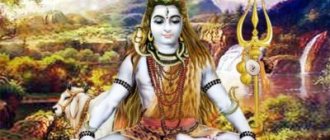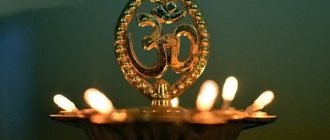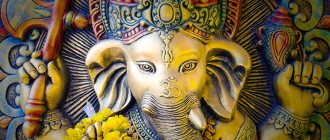Translated from Sanskrit, the name of the god Shiva means “good”, “all-understanding”, “merciful”. Despite this, Shiva is one of the most revered and controversial deities in India. He is part of the triad of supreme gods, performing special functions.
And if Brahma is the guardian of the world, and Vishnu monitors order and harmony, then Shiva, paradoxically, acts as the creator and destroyer of the Universe, and Shiva’s riding animal (vahana) is the white bull - Nandin. Many Indians consider this god the most powerful of all and, it should be noted, this is quite justified. How do Shiva combine the powers of creator and destroyer? What do myths and ancient epics tell about his abilities?
A huge sculpture of Shiva in the Indian city of Rishikesh
What does Shiva look like?
When starting to get acquainted with Shiva, I suggest immediately paying attention to his appearance. Shiva is the god who is impossible not to recognize among other deities of Hinduism. Most often he is depicted in the lotus position, although images of dancing Shiva are often found.
The latter option has become a popular symbol of India, the unspoken emblem of this country. Shiva has fair skin, long dark hair, twisted at the top of his head into a bun (called jatta).
There are extraordinary “decorations” on the god’s neck, legs and wrists. These are the snakes that are entwined around Shiva. They are considered a symbol of unity with nature and the warlike courage of God. In addition, coiled snakes are associated with time, namely the flow of time from the past to the future. According to legend, the sacred river Ganges lives in the hair of the god, and his gaze is like a starry night.
Unlike the same Vishnu, dressed in a royal outfit, Shiva resembles an ascetic (which, in fact, he originally was). His clothing is tiger or elephant skin. The forehead of the god is also decorated with symbolic marks.
The image of the third eye is inscribed on it, as well as three lines that Shiva makes with the ashes left over from the burning of corpses. Probably, such a detail seems creepy for Europeans, but in India everything is different. Such “paint” is the identification of Shiva with the omnipotent deity that reigns in different worlds, reminds us of unity with our ancestors, with our past.
In Indian temples you can also find an unusual image of Shiva, called Ardhanari. Half of it belongs to the man and half to the woman. This image of God speaks of the integrity of principles (female and male), which unites Shiva. Only he is able to give harmony to the vain world he created. But he can easily destroy everything around him. Why is this so?
How many arms does Shiva have?
Shiva is depicted as a deity with four or eight arms . Why does he need so much? The meaning is quite symbolic and has nothing to do with a real person, i.e. he did not have five heads and four arms.
A small Damaru drum is placed in the palms of Shiva - it sounds to the beat of the Universe. The other hand holds the holy fire of Agni, which cleanses and recreates the world anew.
Shiva is also often embodied in statues with a trident. Multi-armedness was not given to this deity by chance. Two hands hold the symbols of Damara and Agni, the others are folded in poses of approval, dominance and strength. The sound of the drum is considered the progenitor of all existing sounds. Thanks to Shiva, the sound “Om” appeared, which later became a mantra. The entire essence of the Universe is concentrated in its sound.
Shiva - creator god and destroyer god
Indians believe that it was Shiva who stood at the origins of time. The great god managed to create the Universe with the help of dance - Tandava. By performing sacred movements in a vigorous rhythm, the god can create, protect or destroy the world. But why destroy what has been created?
Hindu philosophy gives us the answer to this question. According to her, everything in the Universe has its own lifespan, and she herself is no exception. When the world's time expires, Shiva begins to perform the Tandava of destruction. The warlike mighty god destroys the world he previously built so that a new one begins to be born in its place.
Shiva performs a sacred dance, tandava - a symbol of creation and victory of good
What is the danger of a many-armed God?
By his nature, Mahadeva is dual: at the same time he acts as both a creator and a destroyer. At the end of its cycle, the Universe must be destroyed. But if Lord Shiva is angry, he can do this at any moment.
A similar thing happened when Sati died in a fire. Then God became bloody and cruel. He, experiencing the hypostasis of Virobhadra, reproduced himself in thousands of people and went to the palace of Sati’s father for retribution. In anger, he killed everyone around him and cut off the head of Daksha, the culprit behind the death of his beloved. Rivers of blood flowed across the ground, the sun became faded. But the god’s anger passed, and he resurrected all the dead, and Dakshi set up the head of a donkey.
The strongest among the gods
Many Indian legends are dedicated to Shiva and his story. Many of them emphasize the power of God. Once he even entered into a competition with two of his supreme “colleagues”. Shiva turned into a huge pillar of fire, which had no beginning or end.
Then Brahma took the form of a swan and flew high up, but could not reach the top of the sacred Shiva Lingam (pillar). Vishnu, in turn, turned into a boar and began to dig the ground under the pillar. He was never able to reach the bottom. Since then, the gods have recognized that Shiva is the most powerful among them.
Legends about the birth of Shiva
There are several legends about how Shiva was born, and they differ in their narration.
- Brahma meditated for a long time at the beginning of the kalpa about the appearance of a son who would be like him. Then a boy with blue skin appeared on his lap. The baby began to run around Brahma and ask him to give him a name. Brahma named him Rudra, but the boy still screamed, and Brahma had to give him ten more names, and so he got a total of eleven names, as well as eleven incarnations .
- Another version of the legend says that Rudra (Shiva) appeared from the anger of Brahma , between his eyebrows, so his nature became the most negative of the three main energies in Hinduism.
- Another story speaks somewhat differently about the birth of Shiva. Brahma was the son born of the god Vishnu, but Brahma himself had four sons who did not want to have children of their own. Brahma became so angry with them that a boy with blue skin was born from between his eyebrows. The son cried and asked his father to give him a name and position in society. Brahma gave him the name Rudra, as well as ten more names: Mahinasa, Manu, Manyu, Mahan, Bhav, Ugraretas, Kama, Ritudhvaja, Dhritavrata and Shiva. He also received eleven incarnations, which were assigned their locations - these are five different organs in the body, wind, water, earth, fire, life force, Moon and Sun. The incarnation under the name Shiva became one of the three full-fledged gods - Trimurti, along with Brahma himself and Vishnu.
- This legend says that Brahma emerged from Vishnu's navel. The asuras nearby wanted to kill Brahma, then Shiva appeared between Vishnu’s eyebrows from his anger , holding a Trident in his hands, and protected Brahma from the demons.
Shiva Family
It seems to me that the legends about the family of Shiva belong to the most striking myths of India. According to legends, Shiva has three consorts. The first was the beautiful Sati, who sacrificed herself, proving to her father her love for the god Shiva, whom he did not recognize.
Parvati became Shiva's second wife (and she was the rebirth of Sati). This love story turned out to be difficult for the girl. Immersed in deep grief due to the loss of his beloved, Shiva did not want to see what was happening in the world. Only Parvati’s endless dedication, her love and devotion helped God see what he had not noticed before.
Shiva's third wife is Ganga. This is a sacred river that passes through three worlds, crossing heaven, earth and mysterious dungeons. Myths tell that she begins her journey among the stars, where she once saw Shiva and fell in love with him. The beautiful river asked him to weave it into his hair, and Shiva agreed. Since then, Ganga has been a part of God himself.
Attributes
Shiva has many different attributes. Wandering around India, you can notice completely different statues of the same gods. Knowledge of the symbolism of this country helps to understand all the nuances. Often in the hands of Shiva there are weapon attributes in the form of Ajagava (a special bow), Bhindipala (dart), Gada (rod), Khadga (sword), Khatvanga (club with a skull), Khetaka (shield) and various others. Another significant thing is Trishul’s trident (a symbol of evolution, gunas, three faces of time and other concepts).
Ritual attributes include:
- Chillum smoking pipe;
- Shankha shell;
- mudras (position of hands in special poses);
- a jug with the nectar of immortality Kaumudi;
- cup in the shape of a Kapal skull;
- small drum Damaru (symbol of the Universe from which everything around was born);
- Akshamala's special rosary.
Shiva is characterized by several energies: fire (Agni), the heavenly river (he was able to pacify the Ganga) and the power of Shakti.
The image of the deity is closely associated with animals: the snake Naga, the elephant and the tiger (the skins of these animals and the elephant goad), the white bull (Nandin) and the doe (Krishnamriga).
Shiva has special knowledge that can lift a person above this world and bring him closer to the Highest.
Worship of Shiva
The traditional symbol of Shiva is a lingam, shaped like a small pillar. During festivals dedicated to this god, the lingam serves as a sanctuary. It is decorated with flowers, garlands and sprinkled with oils.
The main celebration dedicated to Shiva - Mahashivratri, “The Holy Night of Shiva” - is one of the most important holidays in India. On this day, after sunset, believers go to temples where they bring gifts to God.
Indians believe that it is very important to stay awake all night during the holiday and meditate. For this, Shiva will give a person good luck and prosperity.
The statue of Shiva in Murudeshwar, its height is more than 40 meters
Legends about Shiva are a huge part of Indian culture; they can be told endlessly. This god may seem both merciful and formidable, but he always defends justice and the principles of truth. Shiva is both a great father, a protector god, a formidable warrior, and a kind patron, and therefore it is not surprising that his cult has not lost its power from ancient times to the present day.
Temple
The city of Baijnath in India is famous all over the world for the temple of Lord Shiva. It was built in the thirteenth century and was named after one of the deity’s names – Vaidyanath, which translated means “patronage of healers.”
Once upon a time there was a shrine of Shiva in this place. The rich people of the city wished to perpetuate themselves in the memory of the people and created a new grandiose building on the holy place. These merchants' names were Ahuk and Manyuk. Nowadays, crowds of parishioners and tourists make pilgrimages to the temple.
The outside of the building is surrounded by a wall with two entrances. Shiva was depicted inside the structure as a multi-armed deity (lingam). It is interesting to note that the locals consider this image to be svayambhu (self-created). The walls of the temple are decorated with bas-reliefs of gods from the Hindu pantheon.
The entrance to the building opens with a statue of Nandi (white bull). According to legend, Shiva often rode a bull. The statue is a symbol of pure dharma, sincerity, devotion and courage.
Forms and images
Shiva was first worshiped by the Dravidians, who inhabited India even before the advent of the Aryan civilization. He became the supreme deity in the pantheon of gods they worshiped. According to their beliefs, it was Shiva who ruled the whole world, since he achieved complete self-improvement and self-realization. The Hindu/Vedic Trinity, otherwise known as the Trimurti, consists of three gods: Brahma, Vishnu and Shiva, where Brahma is the creator, Vishnu is the protector and Shiva is the destroyer. This is the true trinity of Vedism, and yet they are inseparable, being different manifestations of one.
God symbol
We have already mentioned the word “lingam” many times. It is with him that Shiva is associated. God was often simply designated by this concept. What is it?
Lingam translated from Sanskrit means “sign, mark”. This is a cylindrical sculpture with a round, less often hemispherical top. Many researchers tend to see it as a symbol of an erect phallus. Ancient Hindus considered the linga to be an abstract image of a deity.
Often it is depicted not by itself, but in pairs with a circle or square, which represents “yoni” (vagina, womb). Today it is generally accepted that these two objects are the oldest mention of the unity of masculine and feminine principles. Only in Hinduism was the masculine eternal and static, and the feminine temporary, changeable and material.
Some scholars see in the linga a prototype of a stambha, a special sacrificial pillar. Cattle that were preparing for slaughter were tied to it.
There is a special ritual that includes washing the lingam, reciting mantras and offering sacrificial fruits, flowers, incense and other permitted items.
Peculiarities
God Shiva is all about contrasts: contemplation and action, creation and destruction, anger and mercy. His image combines many aspects, which is not surprising, because he is considered the Absolute, and the Absolute has everything. He is Mahayogi, the “great yogi,” and also Nataraj, the “king of dance,” but also Mrityunjay, the “conqueror of death,” seated on the throne of Mount Kailash in the Tibetan Himalayas. This is a sacred place of power, which is revered not only by yogis and followers of Shaivism, they strive to climb there, but also by people who study the energy of the earth, its influence on man, his energy and consciousness. Those in the know say that Kailash is truly unlike anything they have seen or experienced before. This is an indescribable experience, after which even great skeptics change their point of view and cast aside all doubts. Lingams also include swayambhus - natural formations resembling the shape of the male genital organ - protrusions and fragments of rocks, tree shapes, etc. Each image created by nature itself has many legends and stories associated with it.
Children
The divine family acts as a form of Shankara, that is, consciousness called upon to create good for the world. Children from the union of Shiva and Parvati are the personification of the balance between the material and spiritual:
- Skandu (Kartikeya) is the god of war with six heads. His power is so great that already on the sixth day of his life he destroyed the demon Taraka.
- Ganesha, the elephant-headed god, is revered in India as the deity of material wealth.
- Narmada is the daughter of God, but in a not entirely traditional sense of the word. Thus, the Lord, practicing deep meditation on Mount Aramkut, separates from himself a share of his energy, from which the Narmada river is created. It is sacred to Hindus.
Historical data
Researchers believe that the history of the god Shiva is rooted in the Harappan civilization. This is the culture of ancient Indians who lived in the lands of Northern India. They were supplanted by the Aryans, who came to the Indus River valley in the third millennium BC. Today, the ruins of their cities are found in the upper reaches, in Pakistan.
We know the Pashupati seal and some lingas (we will talk about the meaning of this word later) of this period. They were among the finds in Mongejo Daro and Harappa.
With the arrival of the Aryans, a new religion emerged. This process is comparable to the introduction of Christianity to pagans in the first centuries of our era. Now a new image appears with which Shiva merges - the god Rudra, the furious and cruel patron of storms, war and destruction.
Isn't it true that history tends to repeat itself? Good pagan gods, like the Greek Pan and satyrs, become evil forces in a new and bright religion. The Aryans believed that it was not sinful to kill “linga worshipers.”
In the Vedas, Shiva is mentioned in the Rig Veda, Yajur Veda and Atharva Veda. In total, the name Rudra has more than five thousand repetitions.
However, there were also supporters of the old traditions, joined by opponents of Brahmanical complexities. What was the point of worshiping the gods all your life if you didn’t receive a reward for it even in your next rebirth? After all, the Vedas say that only brahmins can achieve salvation.
It is noteworthy that in some sects of the new movement (Shramans), the skull of a murdered brahman was considered one of the main attributes of the ritual.
One of the Upanishads (commentaries on the Vedas) contains the most complete and systematized content of the philosophy of Shaivism. This treatise consists of one hundred and thirteen texts and is called "Svetashvatara".










